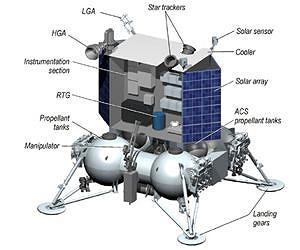Russian scientists at the Space Research Institute of the Russian Academy of Sciences have chosen six venues for landing the Luna-Glob probe. With the launch of the probe in 2014, Russia will resume its Moon-exploration programme using automatic stations, which was started by Lunakhods several decades ago.
 The Luna-Glob probe is designed for studying the Moon's Polar Regions where the environment differs from that in the territories which were studied by the Russian and American "Luna" and "Apollo" programmes.
The Luna-Glob probe is designed for studying the Moon's Polar Regions where the environment differs from that in the territories which were studied by the Russian and American "Luna" and "Apollo" programmes.
The Astronomical Research center (A.R.C) mentioned that during distance probing in the past years, signs of the presence of water on the Moon's surface have been discovered. Water in the form of ice exists in carters in the Polar Regions that are constantly in the sun's shadow. The pores of the moon's soil called lunar regolith are filled with water.
This is similar to the earth's permafrost and can be described as "lunar permafrost". The probe will study its properties using special equipment, which will assess the content of water in the soil. It has a mechanical hand to collect the samples of soil at depths up to two meters.
These samples will be analyzed in detail by equipment onboard the probe. The results will help to reveal from where water appeared on the Moon and also on the Earth because our planet was originally dry and hot, says a fellow at the institute Igor Mitrofanov.
"Possibly, comets brought water onto the Moon and also the Earth. There are two significant differences between the Earth and Moon. The Earth has a stronger gravitational field and a thick atmosphere. Owing to this the Earth could hold out, water and rivers, lakes and oceans appeared, and later, all this led to the origin of life.
"The Moon has no atmosphere and has a weak gravitational field. Water on its surface can be only under the conditions of extreme cold," says Igor Mitrofanov.
Water is necessary not only for research purposes. It is an important resource for the exploration of the Moon, which will be most likely started from the poles, says Igor Mitrofanov.
"When question arises about manned expeditions and setting up of lunar stations, water resources should guarantee the station with oxygen and water for day to day use and can be used to produce hydrogen, an excellent fuel for rockets. At present, we are engaged in hydrology surveillance for the exploration of the Moon in the future," Igor Mitrofanov said.
Luna-Glob will be the first sign of Russia's return to a comprehensive programme to study the Moon. The probe will be equipped with a radio beacon, which will help other probes to land on planned areas with great accuracy.
Several other missions, including the Luna-Resurs will start creating a robotized base on the Moon. This, on its part, will prepare everything necessary for landing a manned mission.
The Russian space exploration programme returns not only to the Moon but also to outer space. The "Phobos-Soil" mission will be launched shortly to study a moon of the planet Mars